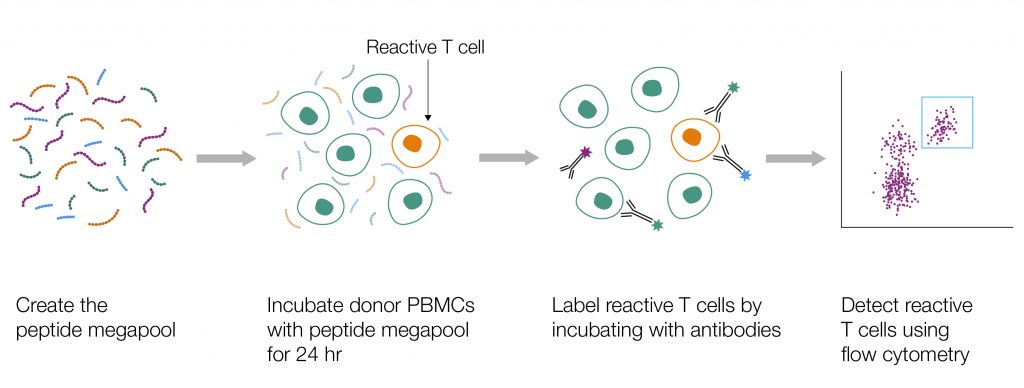Understanding how T cells respond to severe acute respiratory syndrome coronavirus 2 (SARS-CoV-2) is critical in developing long-term therapeutic approaches, as well as helping inform strategies for future pandemics. Learn how one team at the La Jolla Institute for Immunology in San Diego, California, has been using novel T-cell activation assays to understand how our immune system responds to SARS-CoV-2.
The Ongoing Legacy of COVID-19
At the start of the coronavirus disease 2019 (COVID-19) outbreak, researchers sought to understand the reasons why some people suffered only mild symptoms, or even none at all, while others were severely affected (Ng et al. 2020). Other researchers strove to determine prognostic indicators that could identify those in the greatest need of medical intervention, to concentrate scarce resources on the people who needed them the most (Siddiqi and Mehra 2020). While the rollout of safe and effective vaccines has been a game-changer during the pandemic, the fight is not over. There are many unanswered questions and if we fail to learn the lessons from COVID-19 we leave ourselves vulnerable to the next emergent virus.
The Importance of T-Cell Responses
Following the introduction of vaccines, much of the media attention has focused on antibodies to SARS-CoV-2 and there was a great deal of concern about the lack of antibodies to new variants of concern (VOCs), like Delta and Omicron. However, as any immunologist will point out, antibodies are only one aspect of our adaptive immune response — other components also play an important role in combating SARS-CoV-2. T cells are critical in coordinating our response to pathogens and the long-term memory of these cells can make the difference between a dangerous infection and a quick recovery. From the early days of the pandemic, the La Jolla Institute for Immunology has been leading the way in understanding immune responses to SARS-CoV-2.
Understanding T-Cell Activation
In 2020 the La Jolla Institute applied a pioneering method to test T-cell reactivity to SARS-CoV-2 peptides. They used a peptide megapool approach to first identify, then solubilize and pool, specific peptides in the SARS-CoV-2 proteome with an increased probability of being T-cell targets. Then, with the help of the ZE5 Cell Analyzer, they used a novel flow cytometry–based T-cell activation assay to probe the immunological response to SARS-CoV-2 (Figure 1).

Fig. 1. Representation of a peptide megapool T-cell activation assay. Peptide megapools consisting of hundreds of different small peptides of interest are incubated for 24 hr with peripheral blood mononuclear cells (PBMCs) from a donor. This induces expression of activation markers on reactive T cells. After removal of the peptide megapool, PBMCs are then incubated with fluorophore-conjugated antibodies specific for CD4+ and CD8+ T cells and activation markers. Finally, flow cytometry is used to detect the activated T cells.
One advantage of the megapool approach is its ability to easily test T-cell reactivity to specific constituents of the viral proteome. For example, it allows for a direct comparison of spike protein, total proteome, and total proteome minus spike protein. It is this ability to dissect the T-cell response that has allowed the group to answer many important questions related to understanding SARS-CoV-2, such as:
- What are the prime targets of T-cell responses to the virus, and can unexposed individuals have any level of immunity? (Grifoni et al. 2020)
- What is the likely impact of a new VOC in terms of our immune response, and will the vaccines continue to work against the VOC? (Tarke et al. 2021)
- Can we track an individual’s history of infection, even following immunization? (Yu et al. 2022)
Looking Forward
SARS-CoV-2 is still very present, and it is vital that we continue to expand our understanding to help prevent, or mitigate, future pandemics. At Bio-Rad, we appreciate the hard work and dedication of the researchers at the La Jolla Institute for Immunology, as well as all scientific and medical communities, without whom the COVID-19 pandemic would have undoubtedly been far worse.
Peptide megapool assays, like those described in these papers, require a capable flow cytometer. The ZE5 Cell Analyzer offers many benefits to researchers seeking to perform immunological studies and is particularly suited to high-throughput, high-complexity studies that require large numbers of events per sample. Its universal sample loader, fast sample handling, high event rate, and clog-resistant fluidics, as well as the high number of parameters available, make it a great choice for these types of applications.
Find out more about the ZE5 Cell Analyzer.
References
Grifoni A et al. (2020). Targets of T cell responses to SARS-CoV-2 coronavirus in humans with COVID-19 disease and unexposed individuals. Cell 181, 1489–1501.
Ng KW et al. (2020). Preexisting and de novo humoral immunity to SARS-CoV-2 in humans. Science 11, 1339–1343.
Siddiqi HK and Mehra MR (2020). COVID-19 illness in native and immunosuppressed states: A clinical–therapeutic staging proposal. J Heart Lung Transplant 39, 405–407.
Tarke A et al. (2021). Impact of SARS-CoV-2 variants on the total CD4+ and CD8+ T cell reactivity in infected or vaccinated individuals. Cell Rep Med 2, 100355.
Yu ED et al. (2022). Development of a T cell-based immunodiagnostic system to effectively distinguish SARS-CoV-2 infection and COVID-19 vaccination status. Cell Host Microbe 30, 388–399.

